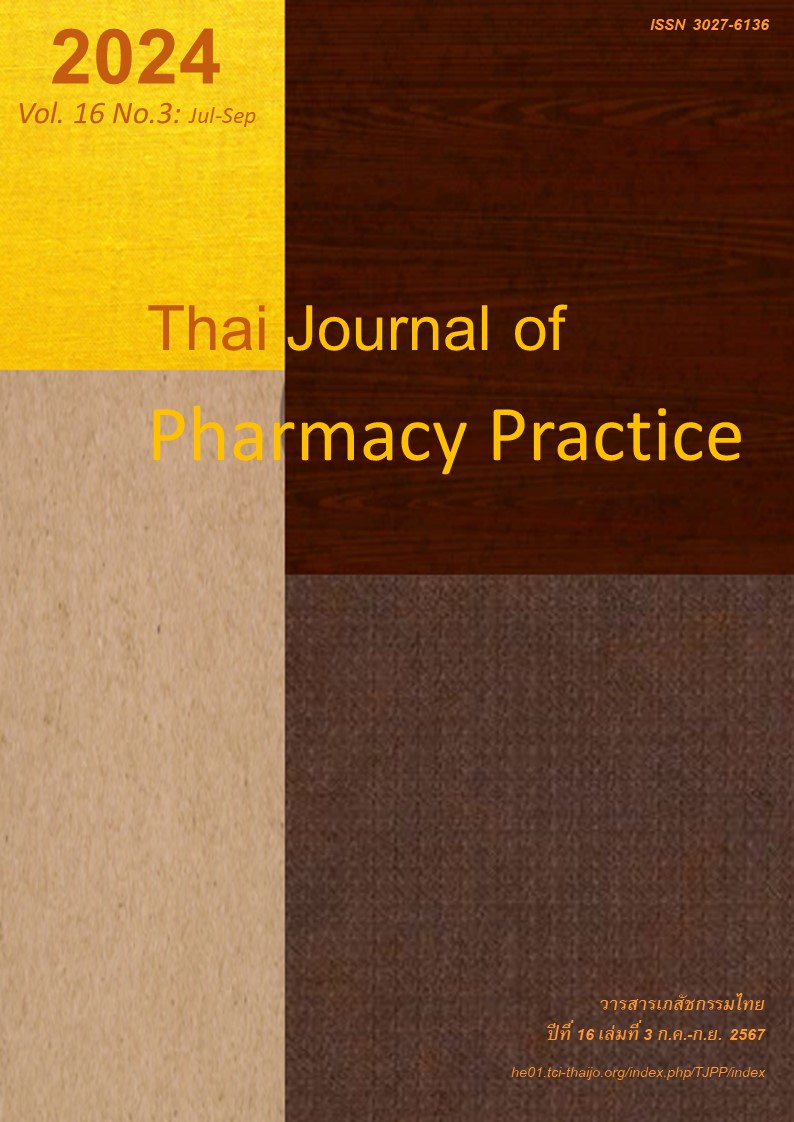Development of Safety Surveillance Systems for Pharmaceutical and Health Products in Wiang Haeng District, Chiang Mai Province
Main Article Content
Abstract
Objective: To develop and evaluate the safety surveillance systems for pharmaceutical and health products (PHPs) in Wiang Haeng District, Chiang Mai, by participatory process among health staff in a community hospital and village health volunteers (VHVs). Method: This action research employed 2 cycles of quality management process (Plan-Do-Check-Act or PDCA) to develop 2 surveillance systems. The first system or proactive hospital-based surveillance was developed from the information obtained from focus group interview among physicians, pharmacists and nurses. Evaluation of the system was conducted by identifying patients with harms from PHPs and number of warning reports on harms being sent to the community. The second system for active community-based surveillance was designed based on the information gained from focus group interview among pharmacists, staff in primary and holistic care, VHVs representatives and staff from sub-district public health office. The participants worked together to establish procedures in the safety surveillance system for PHPs in community with the link to the system within the hospital. The study selected 30 VHVs and empowered them on skills and knowledge in PHPs, and delegated them to monitor according to the system. Outcomes of the surveillance system were the number of surveillance of PHPs in community, identification of adverse reactions of in PHPs by using trigger tools, numbers of data obtained from the hospital, and the assessment of literacy on rational drug use among VHVs before and after the implementation of the surveillance system. Results: Safety surveillance systems arose from participatory process among stakeholders within the hospital and community. Development of the systems involved the selection of groups of adverse reactions from products that should be monitored including steroids, NSAIDs, sibutramine and sildenafil in order to develop trigger tools to detect harms from risky products in the community. The system also established communication channel between the hospital and the community through the VHV LINE application. Rational drug use literacy among VHVs showed a statistically significant increase after empowerment (P< 0.001) from 37.09 ± 12.93 to 40.76 ± 13.70 (full score of 52). The surveillance systems led the communication of risk through appropriate channel to stakeholders. Conclusion: Analysis of risk and development of surveillance systems for health products by multidisciplinary team and network of partners in community, together with empowerment of VHVs, led to the establishment of procedure to identify risk, communicate information on patients’ use of PHPs between hospitals and communities. The systems could lead to appropriate patient care and avoidance of harm from the use of risky PHPs.
Article Details

This work is licensed under a Creative Commons Attribution-NonCommercial-NoDerivatives 4.0 International License.
ผลการวิจัยและความคิดเห็นที่ปรากฏในบทความถือเป็นความคิดเห็นและอยู่ในความรับผิดชอบของผู้นิพนธ์ มิใช่ความเห็นหรือความรับผิดชอบของกองบรรณาธิการ หรือคณะเภสัชศาสตร์ มหาวิทยาลัยสงขลานครินทร์ ทั้งนี้ไม่รวมความผิดพลาดอันเกิดจากการพิมพ์ บทความที่ได้รับการเผยแพร่โดยวารสารเภสัชกรรมไทยถือเป็นสิทธิ์ของวารสารฯ
References
Health Consumer Protection Program, Chulalongkorn University. Consumer situation 2019 [online]. 2020 [cited Apr 1, 2021]. Available from: www.thaihealth consumer.org/news/consumer_situation2019/
Sukamolson S, Sriviriyanuparp W, Kulsomboon V. Priority, prevalence and geographic distribution of unsafe products in Thailand. Journal of Health Systems Research 2016; 10: 65-79.
Suijaitat S, Suttajit S, Suwanaprom P. Effects of health system complexity on antibiotics use in ethnic group of Maechaem district, Chiang Mai. Thai Journal of Pharmacy Practice. 2020; 12: 1065-77.
Office of Permanent Secretary, Ministry of Public Health. Rational drug use community: RDU community. Nonthaburi: Health Administration Division; 2020.
Kerdsri K, Lerkiatbundit S. Relationship between health literacy and self-protection ability among consumers in health products. Thai Journal of Pharmacy Practice. 2019; 10: 239-48.
Vandenbosch J, Van den Broucke S, Vancorenland S, Avalosse H, Verniest R, Callens M. Health literacy and the use of healthcare services in Belgium. J Epidemiol Community Health 2016; 70: 1032-38.
Berkman ND, Sheridan SL, Donahue KE, Halpern DJ, Crotty K. Low health literacy and health outcomes: an updated systematic review. Ann Intern Med. 2011; 155: 97-107.
Ginggeaw S, Prasertsri N. The relationship between health literacy and health behaviors among older adults who have multi-morbidity. Nursing Journal of Ministry of Public Health 2016; 25: 43-54.
Chuemongkon W, Sukyoo P, Kruetiwa N. The effects of medication counseling on drug compliance in peritoneal dialysis patients at peritoneal dialysis clinic in Nopparat Rajathanee hospital, Bangkok. Isan Journal of Pharmaceutical Sciences 2014; 10: 339-53.
Sawaspanich J. Primary pharmaceutical care ser- vices among patients with chronic kidney disease Kantharawichai hospital, Mahasarakham province. Research and Development Health System Journal. 2014; 7: 57-63.
Wattanakul S, Chidnayee S, Sasow P, Tariya D, Panwarin S, Nitirat P. Rational drug use literacy of village health volunteer. Boromarajonani College of Nursing, Uttaradit Journal. 2020; 12: 72-82.
Phodha T, Maluangnon K, Kanjanarat P, Pumtong S. Development of tool and measurement of rational drug use literacy of Thai people. Nonthaburi: Health System Research Institute; 2021.
Best JW. Research in education. New Jersey: Prentice Hall; 1977.
Phodha T, Maluangnon K, Kanjanarat P, Pumtong S. Rational drug use literacy tool: RDUL. Nonthaburi: Health Systems Research Institute; 2022.
Roma W, Kloyiam S. Thai health literacy survey (THL-S) of Thais aged 15 years and above, 2019. Nonthaburi: Health System Research Institute; 2019.
Angsirisak N, Chuenkitiyanon S, Kongjeera A. The effect of case study approach on rational drug use competency in nursing student at Siam University. Bangkok: Siam University; 2022.
Issarasongkhram M. Self efficacy of health volunteers on health promotion participation for elderly in municipality, Nonthaburi. Journal of the Office of DPC 7 Khon Kaen. 2019; 26: 72-82.
Kaewponthong J, Chotikavatchagul S, Klaydesh P, Chamkorm S. Community management for sustaina bility. Dhammathas Academic Journal 2018; 18: 263-73.
Parinyasutinun U. Community management: con- cepts and theories needing to be reviewed. Modern Management Journal. 2016; 13: 11-22.


